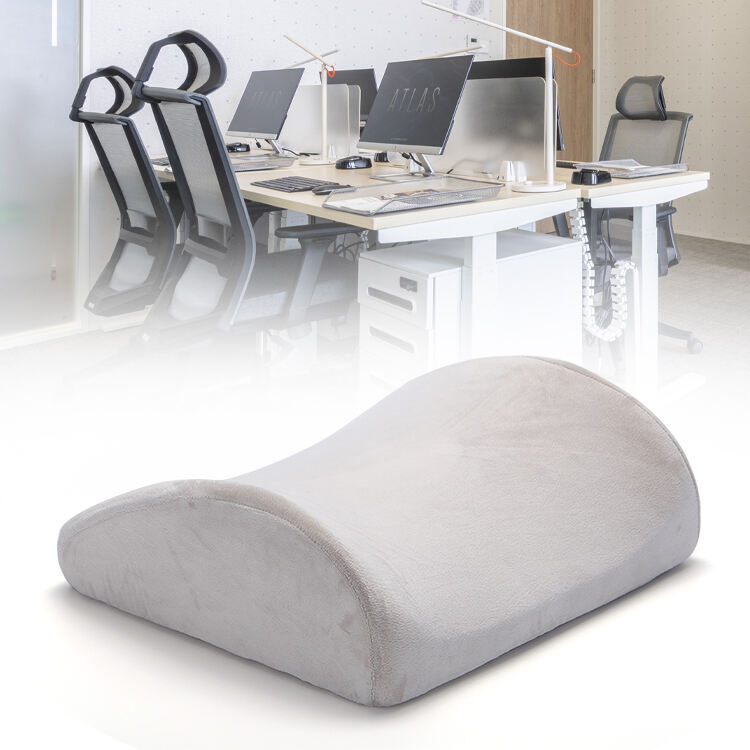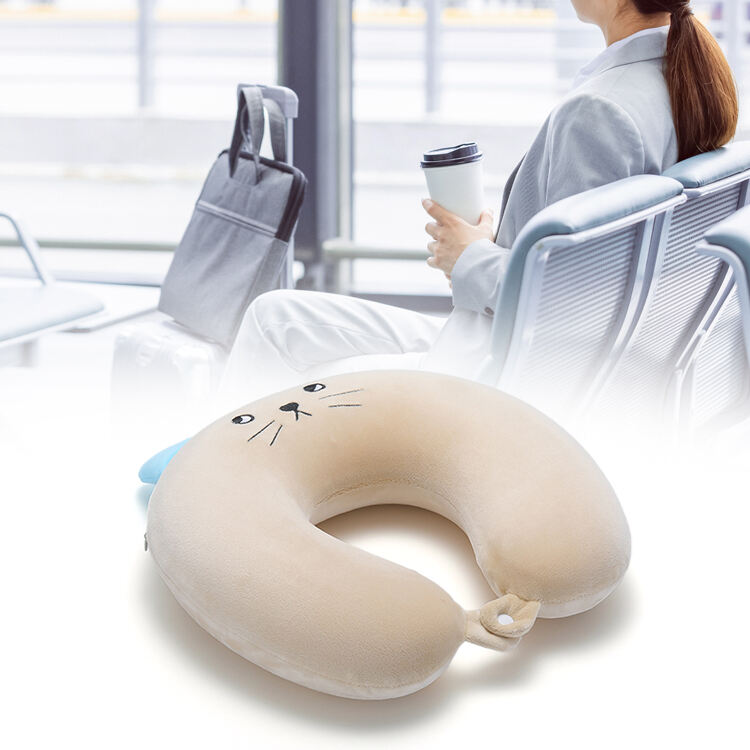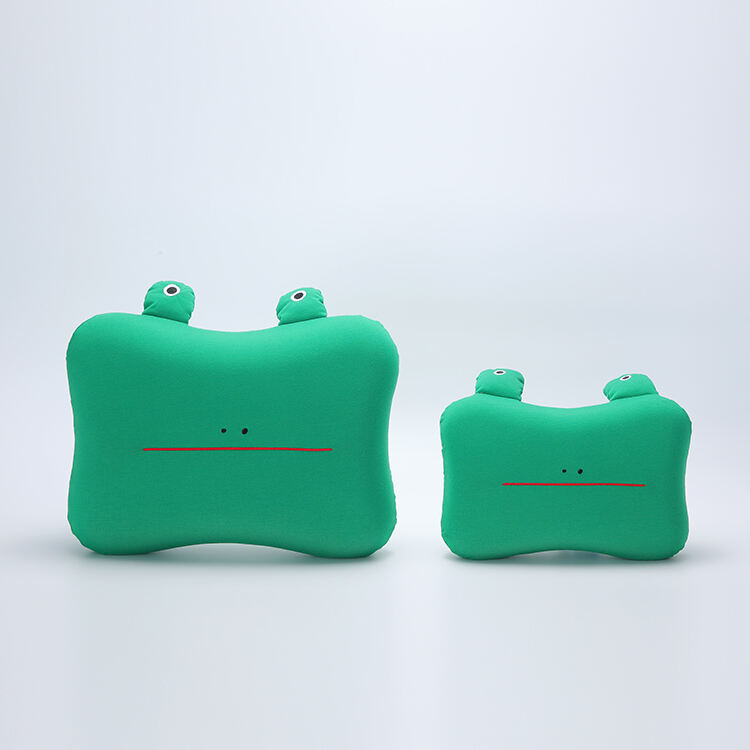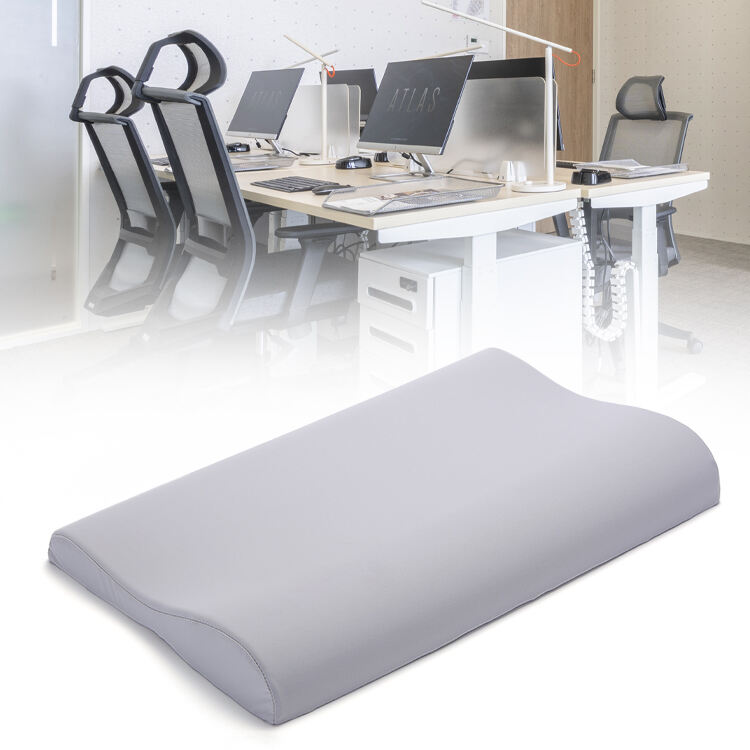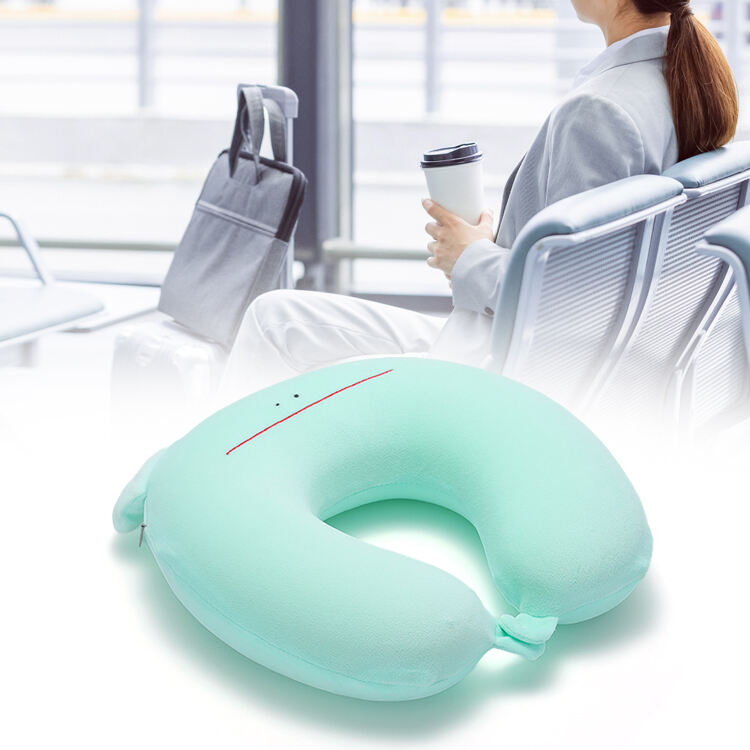Perché i cuscini in schiuma viscoelastica rigidi forniscono un sostegno essenziale durante la notte
La Scienza alla Base del Supporto Adattivo del Memory Foam
I cuscini in memory foam funzionano adattandosi al calore e alla pressione del corpo, una caratteristica che permette loro di conformarsi alla forma assunta dalla testa e dal collo durante il sonno. Distribuiscono il peso in modo abbastanza uniforme sulla superficie, motivo per cui molte persone li trovano comodi. La loro capacità di adattamento riduce quei fastidiosi punti di pressione che possono causare disagio, migliora la circolazione sanguigna nell'area del collo e in generale risulta più rilassante sulle zone dolenti. Studi dimostrano che il memory foam possiede particolari qualità che gli permettono di ammorbidirsi sotto il peso del corpo restando però elastico, tornando alla sua forma originale una volta rimosso il carico. Per chi necessita di un supporto affidabile notte dopo notte, questi cuscini tendono ad essere una scelta privilegiata poiché mantengono nel tempo le loro prestazioni. Fondamentalmente, creano le condizioni per una buona qualità del sonno, soprattutto utile per chi tende a dormire su un fianco, dove il corretto allineamento è particolarmente importante.
Come la rigidità migliora l'allineamento della colonna vertebrale
La rigidità percepita di un cuscino in schiuma viscoelastica è davvero importante per mantenere la schiena correttamente allineata, una caratteristica fondamentale per godere di un sonno davvero rigenerante. Gli studi indicano che i cuscini con un supporto medio o rigido tendono a mantenere la colonna vertebrale nella sua posizione naturale, contribuendo ad evitare fastidiosi dolori al collo e alla schiena spesso causati da cuscini troppo morbidi. Quando la testa e il collo sono allineati correttamente con il resto del corpo, in genere ci si sveglia molto meglio, invece di ricorrere subito agli antidolorifici al mattino. Un altro vantaggio dei cuscini in schiuma viscoelastica più rigidi è la loro capacità di adattarsi alle diverse posizioni in cui si dorme. I dormitori supini ricevono un tipo di supporto, quelli su un fianco un altro, e anche chi si rigira durante la notte trova un comfort costante senza perdere quell'importante sostegno per il collo. Per questi motivi, molte persone finiscono per scegliere questo tipo di cuscini se desiderano svegliarsi effettivamente riposati e senza dolori.
Caratteristiche Principali di un Cuscino in Schiuma Viscoelastica di Alta Qualità
Densità e Altezza: Equilibrio tra Supporto e Comfort
La scelta di un cuscino in schiuma viscoelastica richiede attenzione a due fattori principali: densità e spessore. Queste caratteristiche influenzano notevolmente il comfort e il supporto percepiti durante il sonno. La schiuma viscoelastica di buona qualità ha generalmente una densità compresa tra 3 e 5 libbre per piede cubo. Questo intervallo riesce a offrire il giusto equilibrio tra morbidezza e un supporto solido, adatto a diversi tipi di dormienti. Un cuscino con questa densità si modella in modo uniforme intorno alla testa e al collo, contribuendo a migliorare la qualità complessiva del sonno grazie a un allineamento corretto. Poi c'è il fattore dello spessore, che indica essenzialmente l'altezza del cuscino. Scegliere lo spessore appropriato fa tutta la differenza per mantenere testa e collo nella loro posizione naturale, evitando fastidiosi dolori e tensioni. I dormienti su un fianco di norma necessitano di un cuscino più alto, poiché le spalle occupano spazio, mentre chi dorme sulla schiena potrebbe preferire uno spessore moderato, in modo da garantire un adeguato supporto al collo senza appiattirsi troppo durante la notte.
Tecnologie di raffreddamento per la regolazione della temperatura
Molti cuscini in schiuma viscoelastica sono ora dotati di tecnologia rinfrescante integrata, un dettaglio piuttosto importante per chiunque tenga a un buon sonno. Gli inserti in gel rinfrescante stanno diventando molto comuni oggigiorno. Funzionano disperdendo il calore corporeo, così le persone non si svegliano sudate o con sensazione di calore. Studi dimostrano che mantenere una temperatura fresca durante la notte aiuta effettivamente a dormire più a lungo, favorendo i naturali cicli del sonno. I produttori di cuscini includono anche rivestimenti in tessuti traspiranti e particolari design della schiuma con tante piccole tasche d'aria. Questi piccoli dettagli fanno tutta la differenza per rimanere comodi per tutta la notte. Il flusso d'aria extra previene il fastidioso problema del surriscaldamento, molto comune tra molte persone, specialmente per quelle sensibili ai cambiamenti di temperatura durante il sonno. Quando i produttori iniziano ad integrare funzionalità rinfrescanti nei loro prodotti in schiuma viscoelastica, non stanno semplicemente vendendo cuscini, ma creando complessivamente un'esperienza di sonno migliore. Le persone riferiscono di svegliarsi sentendosi più riposate dopo aver utilizzato queste versioni aggiornate.
Riposo mirato: Cuscini in schiuma viscoelastica per il dolore al collo
Design ergonomici per supporto cervicale
I cuscini in schiuma viscoelastica ergonomici offrono un eccellente sostegno per la zona del collo, aiutando a ridurre dolore e disagio per molte persone. La forma avvolge effettivamente il collo in modo adeguato, mantenendo la colonna vertebrale allineata e riducendo lo sforzo durante la notte, particolarmente utile per chi soffre di problemi cronici al collo. Studi dimostrano che quando una persona dorme su un cuscino progettato ergonomicamente, tende a riposare meglio, soprattutto se affetta da dolore cervicale, ottenendo sollievo dopo una lunga giornata. Quello che rende questi cuscini particolari, però, sono le caratteristiche personalizzabili, come le diverse regolazioni dell'altezza. Le persone possono regolare il cuscino finché non raggiungono il massimo comfort e sostegno. Questa flessibilità fa sì che lo stesso cuscino funzioni bene sia che si dorma sulla schiena, sul fianco o sullo stomaco, permettendo a quasi tutti di trovare una soluzione adatta al proprio stile naturale di sonno.
Migliori Forme di Cuscini per Chi Soffre di Dolore Cronico
La forma di un cuscino in schiuma viscoelastica è davvero importante per aiutare le persone a gestire il dolore cronico. I design a contorno e a cuneo si distinguono perché offrono il giusto tipo di sostegno là dove è maggiormente necessario. Prendiamo ad esempio i cuscini a contorno. Molte persone li considerano la scelta migliore per chi dorme su un fianco, poiché si adattano effettivamente alla forma del collo mantenendo la colonna vertebrale correttamente allineata. Questo è supportato anche da ricerche, che dimostrano una riduzione reale del disagio al collo per chi dorme sul fianco. Poi ci sono i cuscini a cuneo, che sollevano la parte superiore del corpo dal materasso. Questo semplice sollevamento fa una grande differenza per chi soffre di problemi al collo o di particolari condizioni mediche. Ottenere un'altezza aggiuntiva aiuta a ridurre le interruzioni notturne e a dare sollievo a chi soffre di dolore cronico al collo, migliorando complessivamente la qualità delle notti.
Come Scegliere il Cuscino Giusto in Base alla Propria Posizione di Sonno
La scelta del cuscino perfetto che si adatta alla tua posizione durante il sonno è fondamentale per ottimizzare il comfort e mantenere l'allineamento della colonna vertebrale. Esploriamo come i cuscini in schiuma viscoelastica possano soddisfare le esigenze di diverse posizioni di sonno:
Dormitori su un fianco: Supporto sagomato per le spalle
Le persone che dormono su un fianco traggono generalmente il massimo beneficio da cuscini in schiuma viscoelastica che presentano alcune caratteristiche di conformità, utili a mantenere un'adeguata allineatura della colonna vertebrale. I migliori cuscini offrono un supporto sufficiente per colmare lo spazio difficoltoso tra collo e spalle, riducendo la rigidità e il disagio mattutino. La maggior parte degli esperti di sonno consiglia di scegliere un cuscino di altezza adeguata, in modo che la testa non rimanga troppo bassa, creando un comodo passaggio tra le aree del collo e delle spalle. Quando si cercano opzioni disponibili sul mercato, è bene prestare attenzione ai cuscini esplicitamente progettati per chi dorme su un fianco, poiché questi tendono a fare davvero la differenza in termini di comfort e di risveglio riposato, invece che doloroso. Non dimenticare di verificare anche la larghezza della parte superiore del cuscino: deve essere sufficientemente ampia da adattarsi comodamente alle spalle più larghe, senza lasciare spazi vuoti.

Dormitori supini: Consigli per l'allineamento con altezza media
Le persone che dormono supine di solito trovano maggiore beneficio nei cuscini in schiuma viscoelastica con un'altezza media. Questi tipi di cuscini aiutano a colmare lo spazio tra collo e materasso, mantenendo la spina dorsale meglio allineata. Studi dimostrano che quando i cuscini offrono un corretto sostegno al corpo, le persone che dormono sulla schiena si svegliano meno frequentemente durante la notte. Una fermezza media sembra essere la più indicata per la maggior parte delle persone, poiché aiuta a mantenere il collo nella sua posizione naturale senza causare rigidità o dolore. La schiuma viscoelastica di buona qualità sostiene adeguatamente la testa, rendendo il sonno complessivamente più riposante. La forma di questi cuscini mantiene la curvatura naturale alla base del collo, così le persone si sentono effettivamente più a proprio agio al risveglio mattutino.

Comprendere la propria posizione durante il sonno può migliorare significativamente la scelta del cuscino e il comfort generale, riducendo il dolore al collo e permettendo un'esperienza di sonno rigenerante. Che siate dormitori laterali o supini, la scelta del giusto cuscino in schiuma viscoelastica allinea la colonna vertebrale e allevia il disagio, assicurando notti riposanti.
Massimizzare la Durata e l'Igienicità del Tuo Cuscino
Pulizia Adeguata per il Controllo di Odori e Allergeni
Un cuscino in schiuma viscoelastica pulito fa tutta la differenza per riposare bene e far durare più a lungo il cuscino. Quando trascuriamo la manutenzione regolare, questi piccoli problemi iniziano ad accumularsi: si sviluppano cattivi odori, si accumulano allergeni e, alla fine, alterano i nostri schemi di sonno. La maggior parte delle persone scopre che la pulizia mirata è la soluzione migliore per questo tipo di cuscini, visto che lavarli completamente tende a danneggiarne la struttura nel tempo. Aggiungendo un buon copricuscino protettivo, si ottiene uno strato aggiuntivo di difesa contro lo sporco e l'usura. Le ricerche confermano quanto detto; una corretta manutenzione riduce effettivamente la presenza di acari della polvere e altri allergeni nei materiali del letto. Meno allergeni significano meno attacchi di starnuti durante la notte, così le persone si svegliano davvero riposate, invece di dover ricorrere agli antistaminici.
Quando Sostituire il Tuo Cuscino in Schiuma Viscoelastica
Conta davvero sapere quando sostituire quel cuscino in schiuma viscoelastica per ottenere un buon sostegno e rimanere puliti. La maggior parte delle persone nota che i cuscini in schiuma viscoelastica iniziano a mostrare segni di usura dopo circa due o tre anni. Ma fate attenzione a segnali evidenti come le impronte profonde lasciate dalla testa o a strani odori persistenti anche dopo il lavaggio. Il materiale, con il tempo, si degrada e non offre più lo stesso sostegno di una volta, rendendo le notti meno confortevoli di quanto dovrebbero essere. Studi dimostrano che sostituire regolarmente i cuscini può aiutare a ridurre le allergie e migliorare complessivamente la qualità del sonno. Un cuscino completamente nuovo offre un migliore sostegno per testa e collo, mantiene la colonna vertebrale allineata durante il sonno e allevia la pressione dalle zone dolenti delle spalle, che spesso disturbano molte persone durante la notte.
